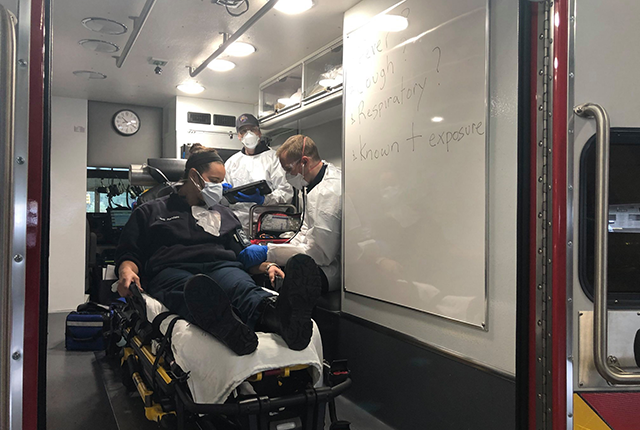
Study: low risk of EMS staff getting COVID from patients
Emergency medical responders' training and use of personal protective equipment is credited for low rate of on-the-job infection.Media Contact:
- Public Health – Seattle & King County: PHPIO@kingcounty.gov
- UW Medicine: mediarelations@uw.edu

The risk that emergency medical service (EMS) first responders will contract COVID-19 from infected patients is extremely low – even when care involves procedures that generate large volumes of respiratory aerosols, such as intubation, a new study has found.
The study was conducted by researchers from the University of Washington School of Medicine and from Public Health – Seattle & King County Division of Emergency Medical Services. Their findings appear in the journal Emerging Infectious Diseases, a publication of the U.S. Centers for Disease Control and Prevention.
Dr. Thomas Rea led the research project. He is a professor of general internal medicine at the UW School of Medicine and medical director of King County Emergency Medical Services. The study’s lead author was Aubrey Brown, a senior UW medical student with an interest in high acuity medicine.
In the study, the researchers examined the work records of 3,000 EMS workers in King County during 2020, from mid-February to the end of July. King County is a 2,300-square-mile metropolitan region encompassing Seattle. It is home to 2.3 million residents.
An EMS provider was considered potentially exposed to COVID-19 if the patient had a positive SARS-CoV-2 swab sample within 10 days before or three days after the encounter. A provider infection was attributable to such a patient encounter if the provider first tested positive two to 14 days after the encounter.
During that time, 1,592 of the EMS providers cared for 946 different COVID-19 patients, resulting in a total 3,710 encounters in which a provider cared for an infected patient. Of those 1,592 EMS providers, 655 (41%) had one encounter with an infected patient, 417 (26%) had two, and 520 (33%) had three or more. In 182 (16%) of these encounters, an aerosol-generating procedure was performed.
Of the 1,592 potentially exposed providers, only one tested positive for SARS-CoV-2 within two to 14 days of an encounter with a COVID-19 patient, representing an extremely low incidence of 0.28 cases/10,000 person-days at risk. The single EMS case linked to contact with a COVID-19 patient involved an encounter in which an aerosol-generating procedure was performed.
An additional 18 EMS providers cared for COVID-19 patients and acquired COVID-19. However their COVID-19 positive tests were well outside the 14-day incubation period after care. An additional 11 EMS providers who never cared for a patient with COVID-19 also tested positive for COVID-19.
“Our findings should help reassure first responders that emergency care in general, and specifically when performing aerosol-generating procedures, can be delivered safely to patients as long as personal protective gear is properly deployed,” Rea said.
Researchers noted the importance of adhering to protocols on every response, as one-third of the COVID-19 patients did not display common symptoms such as fever, cough, or shortness of breath.
King County EMS personal protection protocols include wearing a mask, eye protection, gloves and a gown. Surgical masks were considered sufficient for treating patients not requiring an aerosol-generating procedure, but an N95 respirator was required when patients underwent such procedures.
The finding that nearly all COVID-19 cases among EMS workers resulted outside of patient care underscores the importance of social distancing, masking, and handwashing, the researchers said.
Rea pointed out one notable limitation of the study: It occurred before the availability of vaccines and the presence of the more contagious delta variant.
"While provider vaccination might further reduce patient-provider transmission risk, the delta variant could increase risk, as it is more contagious. The balance of these two new factors is uncertain in this setting and provides impetus to continue to evaluate occupational risk," he said.
– Michael McCarthy wrote this news release.
For details about UW Medicine, please visit https://uwmedicine.org/about.